As some regions are looking ahead to a parched, dry summer, a lot of people might be reconsidering the idea of planting a vegetable garden at all. Implement some of these drought resistant vegetables and water saving methods in your gardening plans to harvest food from your backyard in spite of the climate.
Be sure to check out this handy guide on watering vegetables the right way.
Originally published January 2014; this post has been updated.
New to gardening? Limited on space? The 5-Gallon Garden gives you the skills you need to grow food in the space you have. Get started with your garden today!
Water-Wise Methods
There are a number of tactics to consider that will allow you to harvest fresh veggies from your home garden, despite water restrictions or a water shortage.
Choosing drought tolerant plants is just one solution. [Check out these heat tolerant vegetables if you’re facing a drought situation in your region.]
But there are some other tactics to embrace as well.
Grow Some Greens!
Ready to grow fresh greens, no matter WHERE you live? Sign up for my
FREE quick-start guide and start growing some of your own food!
Dig the Shoulder Seasons
Expand your spring and fall garden plans. Trying to keep vegetables growing through the hottest months with limited water will frustrate even experienced gardeners.
Instead, take advantage of crop varieties that thrive in cooler weather. Peas, greens, beets, turnips, and radishes will do just fine without the summertime heat.
Relief from the Sun
Think about shade. Even plants that like full sun will appreciate just a little bit of afternoon shade if they’re struggling with drought conditions and heat.
Situate your garden so that they’ll catch a little shade from trees you have on site. No trees? A patio umbrella or strategically placed shade cloth can help your garden tolerate a drought situation better.
Similarly, space your plants so that they are just touching at full size to create a shaded—and cooler—soil surface.
Deep Watering
When you do water, water plants deeply. This encourages plants to sent roots further into the ground. Surface watering might give plants an initial boost, but those surface roots tend to dry out more quickly than deep root systems.
Home gardens are the perfect place to experiment with an olla irrigation system. This is a traditional method of deep watering. When planting a vegetable garden, submerge an olla—a porous vessel—in the ground near the base of your plants, leaving the top accessible.
Fill the olla with water and it will slowly seep into the ground and be available as the plants need it. While ollas are available pre-made it would be expensive to outfit an entire garden with these. Not to worry; you can easily make your own with terra cotta pots — see the how-to in my book.
Try deep watering with a drainage pipe or even a nursery pot buried next to plants. Instead of watering at the surface, water into the pipe or pot so the water goes straight to the roots. Another alternative is to poke several small holes in a recycled plastic milk jug, fill it with water, and let it slowly seep water into the ground next to a plant.
When you’re establishing new plants in the veggie garden, you’ll need to water more regularly, but once they’ve developed a deeper root system, the plants will be able to handle some dry spells, allowing you to stretch the time between watering.
Water Retention
Amend your soil to incorporate lots of compost. A soil that’s rich in compost will be able to hold onto what little soil moisture there is. Something to really consider when you plant your own garden.
Mulch, mulch, mulch! Adding 3″ to 4″ inches of mulch will help prevent the soil surface from drying out. Try straw, leaves, grass clippings, or wood chips to create a more drought tolerant garden. I’ve even seen people use shredded office paper, though it does look a bit like a random snowstorm hit. Consider using some of these permaculture methods in your vegetable garden design phase, too.
Consider trench composting. By burying your kitchen waste alongside your plants, you’re nourishing your plants and also adding a bit more moisture to the soil. Sheet mulching is another method of gardening that improves moisture retention.
Keyhole gardens, popular in Africa, are used in other hot, dry climates as well. Keyhole gardens (so named because of their shape) have an active compost pile at their center. The central compost helps nourish the plants growing around it and acts as a source of moisture. Supplemental water goes right into the compost “well.”
A soaker hose or drip irrigation system allows you to put water right where you want it and can reduce water waste seen when sprinkling. Invest in a simple timer and set it so that it goes off at night. That will give your plants a chance to drink up before the sun heats the ground, causing evaporation.
Dry Farming
I recently learned about the idea of “dry farming” tomatoes. It seems a method well-suited to drought, and I’m told the resulting fruit is superior. You do, apparently, need good soil in order to pull this off. Essentially, you’ll water your tomato plants to get them established, then water sparingly as fruit matures.
Related: Planting Vegetables that Grow in the Shade for a Successful Harvest
Hugelkultur
If you have access to logs, branches, leaves, and other natural debris, consider trying the hugelkultur method. Simple enough that anyone can try it, this method is essentially just a matter of stacking natural material into a mound and planting on top of it.
The decomposing matter turns into rich soil that will hold moisture, requiring little or no irrigation by the second year, mitigating some of the effects of drought. Yeah, it’s not going to solve your problem this year, but if another year of drought follows this one, you’ll be happy you got a jump on it.
Choose Drought Tolerant Vegetables
When planting a drought resistant vegetable garden, choose drought tolerant varieties of the crops you’d like to grow. There are drought tolerant varieties of beans, broccoli, chard, corn, cowpeas, cucumbers, eggplant, melon, okra, peppers, squash, and tomatoes.
- Tomato Dirt has a list of both hybrid and heirloom tomatoes that do well in drought-like conditions.
- Southern Exposure Seed Exchange suggests sticking with Tromboncino squash, and recommends specific varieties of drought tolerant plants. Choose from pole beans, eggplants, and peppers that do well in hot, dry conditions.
- Choose vegetables that have a short growing season. Beans, for instance, can produce a full crop in a relatively short amount of time, using less water than a crop that takes longer to mature.
- Corn is shallow rooted and not a great choice for growing during a drought. Opt for a more drought tolerant variety if you really want to grow corn.
- And don’t discount trees. They may not fit your idea of a “garden” plant but they do provide food and are generally drought resistant. Once established, most fruit trees can get by with very little supplemental water. [More about growing fruit trees here.]
Choose vegetables that produce a lot of food per plant. While a broccoli plant provides just a single head, tomatoes, squash, peppers, and eggplants, for example, will produce enough for many meals. Do your research to find drought tolerant varieties.
In addition to watering deeply, choosing vegetables that have a deep root system allows you to water less frequently. Tomatoes, melons, asparagus, and artichokes are fairly deep rooted.
Water
Don’t let water down the drain if you don’t have to! Collect it and use it to water your plants.
- Warming water for showering or dishwashing? Catch the water in a five-gallon bucket to use as irrigation water.
- Place a 5-gallon bucket in the shower with you while you’re showering to catch some of that water.
- Water used for cooking pasta, potatoes, or hard boiled eggs can be taken out to the garden once it’s cool.
- Instead of rinsing dishes under running water, do it camp style. Rinse them in a dish pan, then use the water in the garden.
- If you’re bathing a baby, that water, too, can go out to the garden.
If your growing area is sloped at all, consider creating swales to slow down any rainwater that does come from the sky. Geoff Lawton uses this technique as part of his permaculture method.


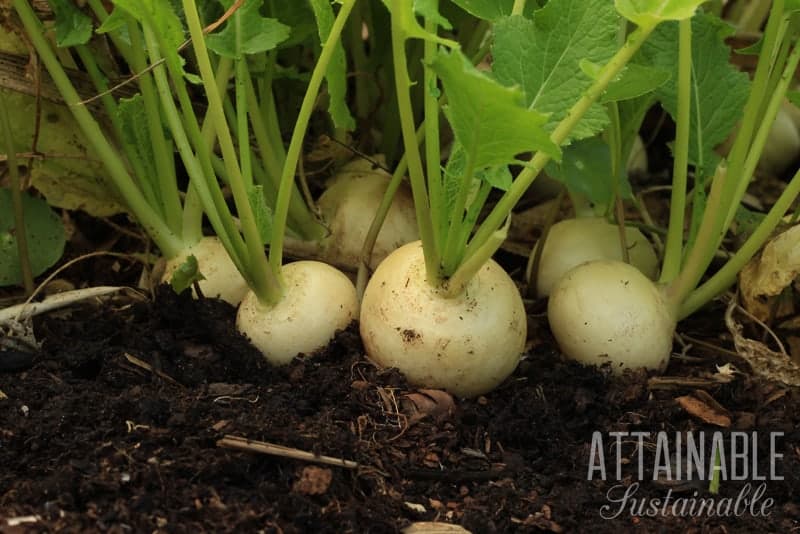
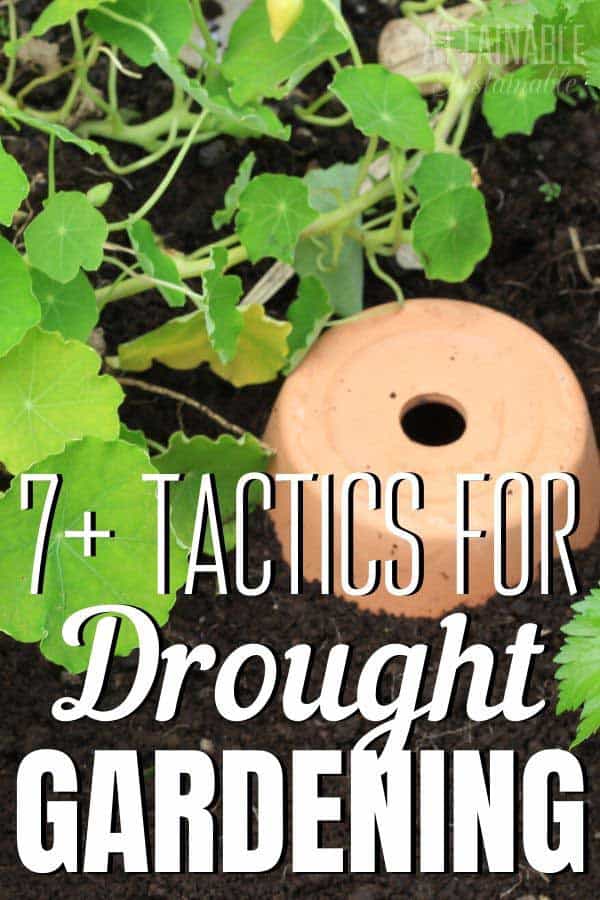
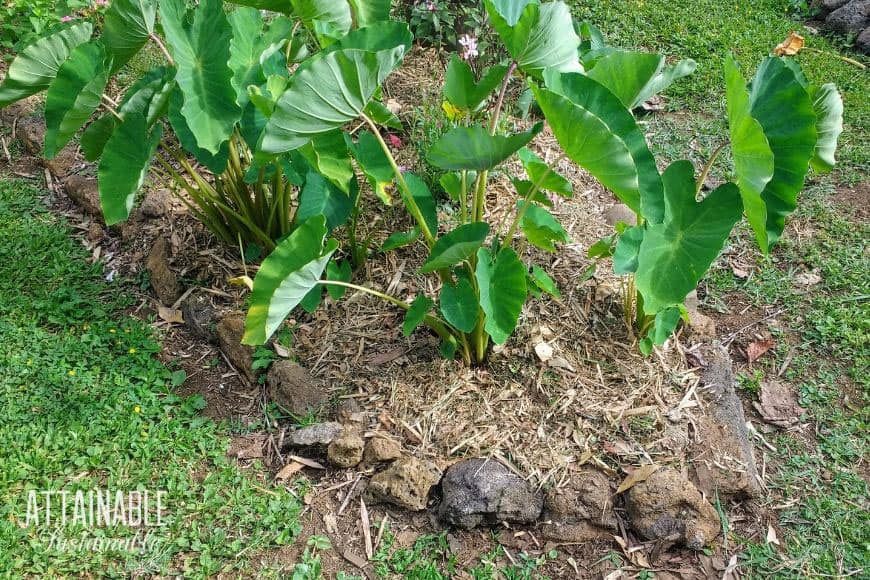
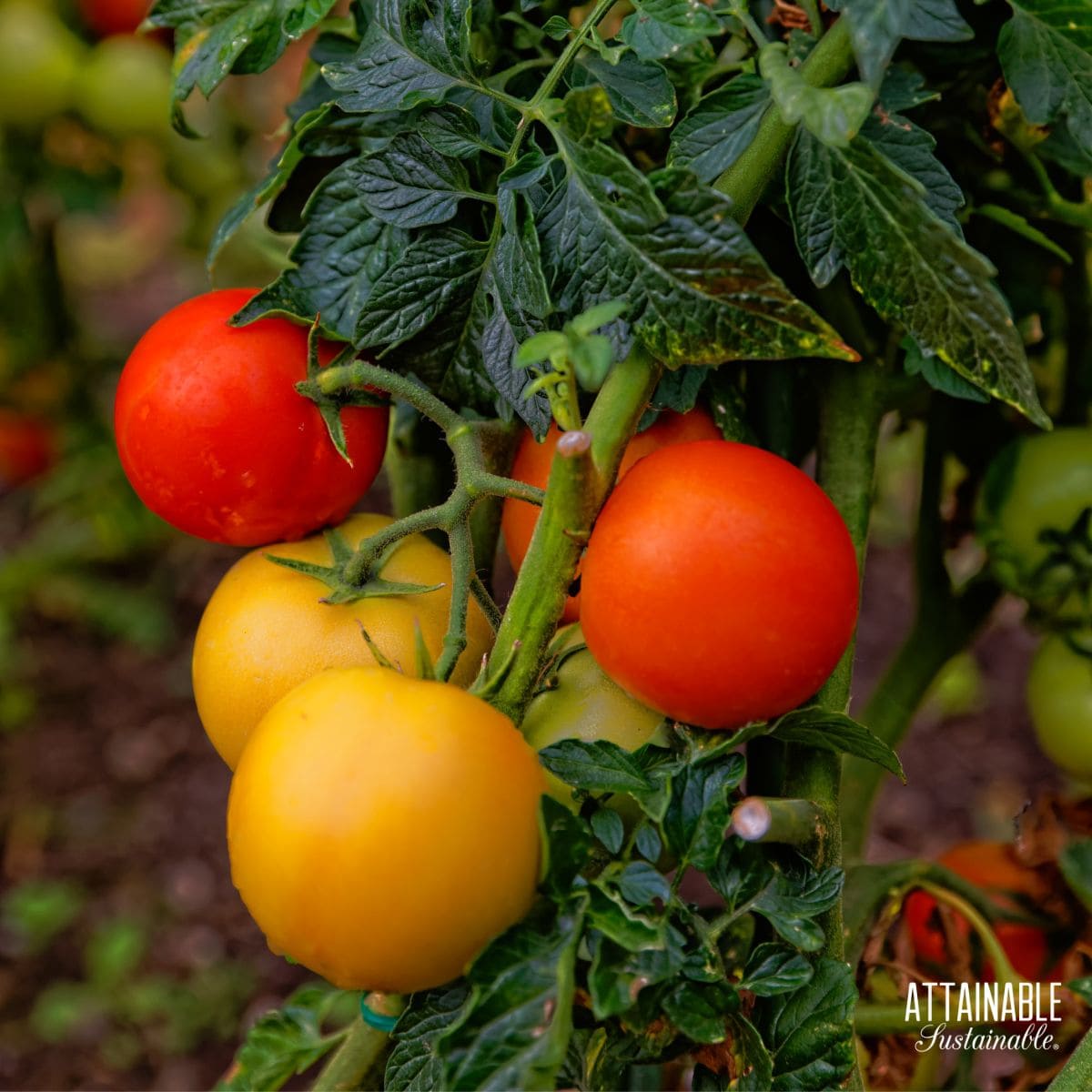
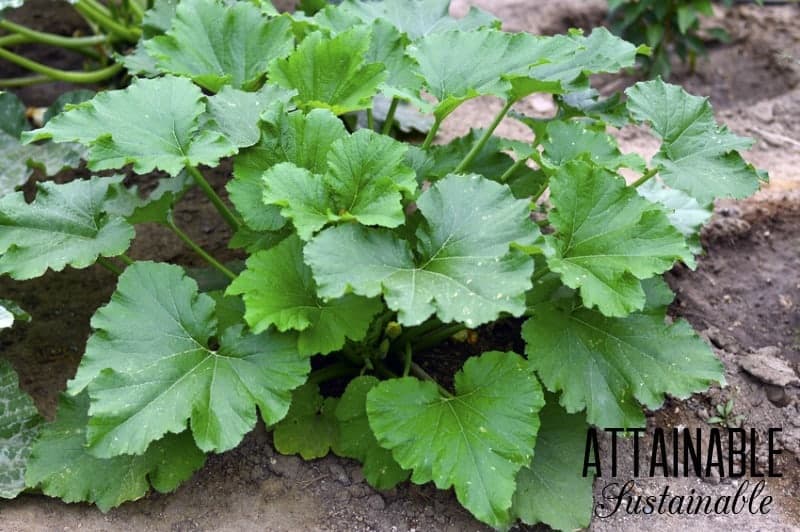
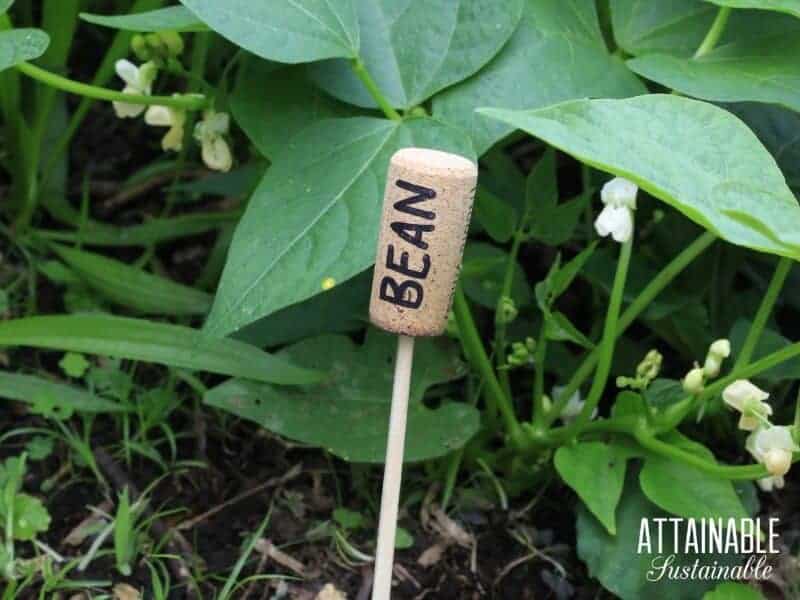
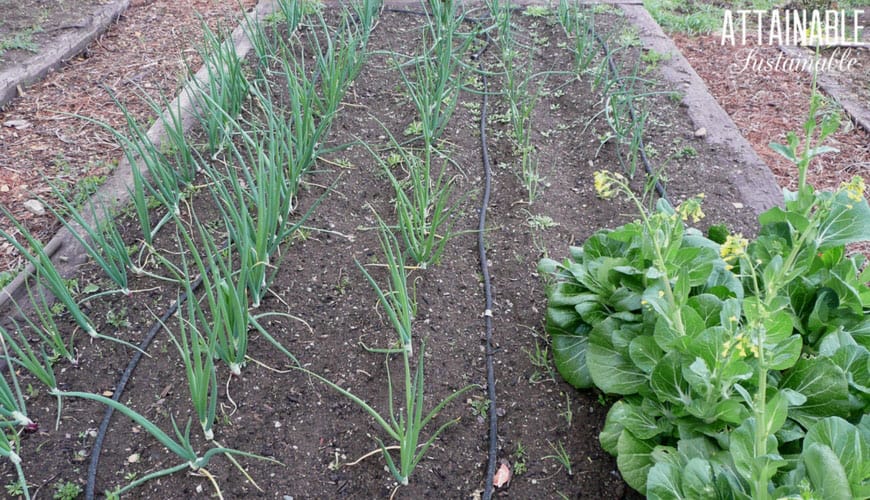
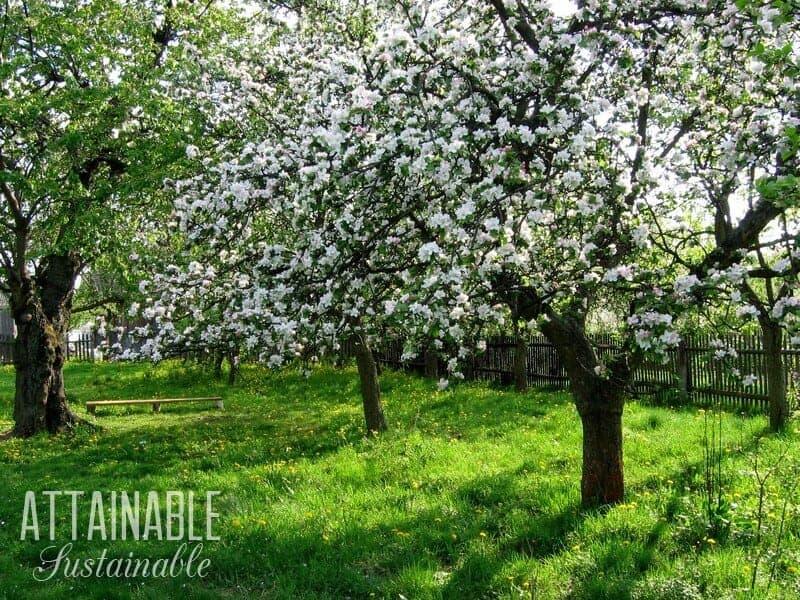





I had 3 raised beds built when we were doing some landscaping about 12 years ago. I think they were originally filled with native soil (mostly clay) with some topsoil added in. Tomatoes and cucumbers did very well. Then my job got in the way and I allowed my raised beds to lie completely fallow for about 7 years. Now I’ve been doing a lot of reading and realize that was a bad thing to do. I’ve been making great compost for the last 2 years but I don’t think it’s penetrating the hard layer beneath it. Any suggestions?
It’s hard for me to say without being there, but have you tried deep watering and loosening the hard pack underneath to at least mix some of your compost in?
I have a few strategies for dealing with drought conditions. The weather tends to get hot enough by late June or early July where I live that most lettuce tends to die, so I grow lettuce that is drought tolerant. I plant a row of it in the garden that I pick from in the spring. I also plant some in pots that I can move around depending on how hot it is, where the sun is, and whether it is raining. To avoid having to water every plant every day, I water really well every other day and I fill old wine bottles and bury them in the soil to water the plants at the roots in the between times. This works really with basil, which usually needs a lot of water, but by watering it at the root like this, I don’t need to use as much water. I also use a rain barrel to water potted plants. I also have chives, which I plant in pots and keep in a partially shady area. By keeping them in shade, they need water only once a week.
Great tips, thank you for sharing.
Kris, I like your review of the many things we can do in drought – and when drought threatens. I am with you – do not give up gardening! Learn new ways you can grow. I’ve posted your article on my personal facebook page: Nan Curtis Sundgren, and I will also post it on my PrairieGrowersGuide facebook page. You can see in my post what I will be doing this coming season, whether we continue to get more rain than usual – as we certainly did last season! – or whether we have to deal with drought and / or unstable, irregular weather patterns.
I think you would enjoy getting to know about cover cropping! Kansas/Nebraska Soil Stewardship Group is a bunch of people (1417, at last count) – mostly ‘boots on the ground’ farmers and ranchers, soil scientists, ag advisors, anyone connected with agriculture really who is doing no-tilling and cover cropping, or who is interested in it.
I have a small container gardening and I reuse the water from the kitchen: what I wash/cook vegetable, a part the water to take showers etc. Here the water is verrrry expensive ( 4euro m3, 1 euro > 1 dolar), so people become inventive: they reduced the consumption of chemicals, use biodegradable products to clean, and the water from the house is used in the garden. I sow even a toilet with sink incorporated ( water from the sink used in the toilet).
Think too at the permaculture and the layers of vegetation: some plants will keep shadow and to not loose all the humidity.
Sounds like you’ve learned to be very water savvy! We could all learn something from you, I think.
Great website.
I live in an apartment now. I started a garden indoors. I use “terrariums” made from 2 litre bottles, no cap. Instant terrarium. Terrariums self-water, almost. For now, I grow onions and parsley. I even started some spruce trees (about an inch high now). Soon doing carrots and beans.
“Water used for cooking pasta, potatoes, or hard boiled eggs can be taken out to the garden once it’s cool.”
Never mind the garden. Use this water to make soups, stews, or even drink it. The water is full of minerals and vitamins. Yes, good for plants, but better for us. I freeze this water and when I have enough, I make a batch of soup/stew. Then freeze any leftover broth to reuse in next soup/stew.
I do use SOME in cooking, but I find I’m usually inundated with more than we can use!
I’ve used cooking water on houseplants and even bedding plants but now, for me, I dilute old tea and coffee into my houseplant watering container but I’ll keep pasta/potato water, especially, for soups and sauces because it tends to go stinky and scummy even in planted pots.
Drought can be so tough on the garden, and in my opinion survival is really all about preparation https://bit.ly/1FvILrk
I live in an area where we switch back and forth from very wet (its a swamp) and drought conditions. This year, I documented all my activities trying to protect my garden on my blog – I found this year easier than most! https://bit.ly/1FvILrk
Glad I found your site! Not sure how, maybe Twitter? I’ll be coming back regularly for garden inspiration.
My version of an olla pot is a Home Depot bucket mostly buried with holes in the bottom and near the surface. I fill it once a week and my tomatoes (two Early Girls, one Ace) get a deep soak. They are growing like weeds and are producing lots of fruit.
use the water from rinsing your clothes. You can separate the ” grey water ” from your sewage and use it to irrigate your lawn/ vegetable garden. Many of us in New Mexico do this. I requires forethought when building, or a plumber if it is an afterthought. All your shower water goes there, too.
Living in Australia, we are constantly trying to minimize water usage, so in our vegie garden we are turning to wicking beds. We now have 3 up and running and it saving us a huge amount of water and $$$$$$$$. Our vegies are thriving in them and we only have to top it up once a week. Because the water is drawn up through the manured soil, the plants only take what they need. No more watering not only the vegies, but everywhere else as well. Eventually we will replace all our beds with wicking ones. So far I cannot find a fault with them.
The price on that amazon olla is outrageous. I couldn’t imagine asking that much for one in our shop. Aside from making your own from terra cotta pots, you can inquire with your local potter or ceramics department at a nearby college or community center. Sustainable AND local. Keep it in the community. For sure shop around, Dripping Springs strikes me as a chic price gouger.
For a cheap cheat just use a 2 liter or similar bottle with the bottom cut off and place the top (so it looks upside down) into the soil and fill it up. It will slowly drain into the soil under the plant directly to its roots.
I fill old wine bottles and turn them upside down and bury them in the soil several inches.
No mention of aquaponics? This gardening technique requires only 10% of the water required for traditional gardening while supplying fresh fish to harvest as well.
I would love to know about a really easy way to set this. I would like to try, but when I read about all the materials required, I am thrown off thinking about all the materials I would have to buy to do it. If I can’t do it without spending hundreds to do it, I would not do it.
Iowa was dry last year, really dry. We are looking forward to building our keyhole garden for next year, since our spring to-do list might be too full to get to it. I was thinking of two: one larger one for vegetables, and a smaller one that I can cover to grow greens into the winter. A good compost should generate some warmth for the winter, right?
I visited LA and Palm Springs last summer and I saw lots of use of drip irrigation but no where did I see use of mulch. I just don’t get it! There are so many benefits of using mulch and the commercial landscapers don’t see the benefits? Maybe because it’s not their money??
I absolutely love the documentary Back to Eden. We built our whole garden around this method. You can watch it free online. I’ve started lots of people on it. Last year once my plants were established I didn’t water at all (except my strawberries) and had a great garden. I live in an area that gets about 16″ of rainfall a year. It’s a very dry, arid climate. It is so simple but makes so much sense.
Thanks for the suggestion of Back to Eden. I’d like to learn more about lessons that have been lost during our quest for progress. Ha! Laughable!
nice suggestions.
Another dry farming method is to allow more space for individual plants. Plant farther apart to reduce competition between plants and mulch, mulch, mulch.
All good suggestions, and I’ve used mulch, hugelkulture, and drainage pipes-instead-of-ollas with good results. But I would be careful of the last idea, using the baby’s bathwater in the garden. On ornamentals, trees, or bushes, okay, but not on veggies – naturally you clean the baby’s bottom before you plop him/her in the tub, but still – you can’t SEE germs. Better safe than sorry. Other than that, great article – thanks!